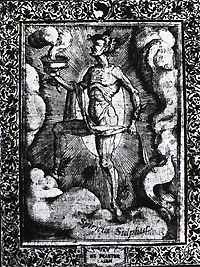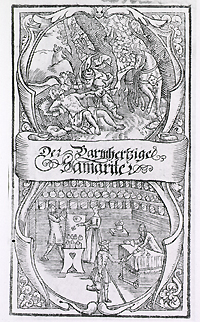The Paracelsian Debates
The growing interest in the works of Paracelsus in the third quarter of the sixteenth century led to an ever increasing number of publications, translations and commentaries on his works. At stake was the question of educational reform, the relation of religion to science and medicine, and the relative value of ancient authority to fresh observational evidence. The role of chemistry in all of this was crucial.
It would be wrong to picture the growing confrontation in terms of stark contrasts. To be sure, Peter Severinus sought to establish the superiority of Paracelsism to Galenism in his important Idea medicinae philosophicae (1571) while Thomas Erastus upheld the authority of Aristotle and Galen and damned the innovations of Paracelsus in his Disputationes de medicina nova Paracelsi (1572-1574). These were but the opening salvos of a confrontational literature that extended over more than a century.
And yet from the beginning there were those who sought to chart a middle course. Albertus Wimpenaeus of Munich wrote his De concordia Hippocraticorum et Paracelsistarum in 1569 and here he admitted that although he followed Paracelsus in some matters he also followed the ancient authorities. Even more important was the venerable Johannes Guinter of Andernach, who late in life, began to read the Paracelsian texts. In his massive De medicina veteri et noua . . . (1571) Guinter held to much of traditional medical theory, but he hoped to conciliate the warring factions. He wrote that Paracelsus himself was an arrogant man, but Guinter felt that there was much of value in his chemically-prepared remedies. He sought to show the similarities between the Aristotelian elements and the Paracelsian principles and he argued that the macrocosm-microcosm analogy had been employed by some of the ancients as well as Paracelsus. He also suggested that cure by similitude was not so different from that by contrariety.
The works of Severinus, Erastus, Wimpenaeus and Guinter give some idea of the range of opinion that had developed by the early 1570s. The tone of the debate became far more bitter in the coming decades. By 1612 John Cotta expressed the views of many when he wrote that "the innumerable dissentions amongst the learned concerning the Arabicke and Chymicke remedies at this day infinitely, with opposite and contradictorie writings, and invectives, burthen the whole-world." Although there was some debate over the more mystical views of the later Paracelsians, the most inflammatory point was the use of chemistry in medicine.

Figure representing "The Spirit of Sulphur." Engraving from Leonhard Thurneisser zum Thurn, Quinta essentia ... und Alchemia.
In France the internal use of antimony was being promoted as an effective purgative -- and specifically as a Paracelsian cure -- by the early 1560s. The conservative medical faculty of Paris reacted quickly, charging that antimony in any form was a dangerous poison that should not be taken internally (1566). In a series of decrees and court cases this powerful body tried to forbid any use of chemistry in medicine. Nevertheless, publishers continued to print books favoring medical chemistry, and by the early years of the new century courses in the preparation of pharmaceutical chemicals were available in Paris. In the 1630s the medical faculty forced Théophraste Renaudot to close his Bureau d'Adresse where he fostered the use of pharmaceutical chemicals. But in 1641 the establishment of the Jardin des plantes provided for a professor who taught chemical operations. Although the medical faculty won repeated legal battles, they could do little to end the growing use of chemical remedies which became ever more fashionable among the younger physicians. After Louis XIV was cured with an antimony purge (1658) the end was in sight. An assembly of the medical faculty in 1666 resulted in an overwhelming vote accepting antimony as an approved purgative, and after that time there was little resistance to the use of chemical medicines along with more traditional cures in France.
The English reaction to the new chemical medicine was closely related to the French scene. As in France, the first English references to Paracelsus appear in the 1560s. In this case we find that the authors had lived in exile in Switzerland during the harsh reign of the Roman Catholic Queen, Mary. But if the London College of Physicians was initially hostile to the chemists, this attitude gradually faded. By the mid-eighties the Fellows of the College planned an official pharmacopoeia that was to include a section on chemically-prepared medicines. Thomas Moffett who had taken his M.D. at Basel, and was a friend of Peter Severinus, was placed in charge of this section since he had already written a defence of chemical medicines (De Jure et Praestantia Chemicorum Medicamentorum, 1584). Although the project was abandoned at that time there is evidence of an increasing interest in the value of chemistry. R. Bostocke wrote an apology for the entire Paracelsian system in 1585 and reference to specific Paracelsian preparations appear in the works of a number of late Elizabethan surgeons.
After the turn of the century, the medical faculty of Paris went on the offensive once more, this time against such defenders of chemical medicine as Joseph Duchesne (Quercetanus) and Theodore Turquet de Mayerne. Turquet ultimately left the country for London where he revived the dormant pharmacopoeia project of the College and pressed for the inclusion of chemically-prepared medicines. The preface to the Pharmacopoeia Londinensis of 1618 -- surely written by Turquet -- states that
we venerate the age old learning of the ancients and for this reason we have placed their remedies at the beginning, but on the other hand, we neither spurn the subsidiary medicines of the more recent chemists and we have conceded to them a place and corner in the rear so that they might be as a servant to the dogmatic medicine, and thus they might act as auxiliaries.

The new pharmacopoeias helped improve the dispensing of medications in Renaissance pharmacies. Woodcut from E. Feynon, Der Barmhertziger Samariter.
In short, although interest in chemical medicine may have originally been centered in Germany and Switzerland, it became widely known in England, France, and other European countries during the late sixteenth and early seventeenth centuries. This influence was even to be found in the Ottoman Empire where an Arabic work titled the New Chemical Medicine Invented by Paracelsus was completed by Salih Ibn Nasrallah Ibn Sallum no later than 1640. The relatively large number of manuscript copies of this work attest to the fact that the Paracelsian union of chemistry and medicine had spread beyond the borders of Western Europe by the mid- seventeenth century.

